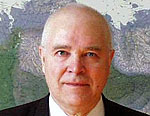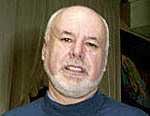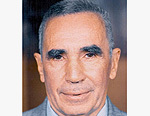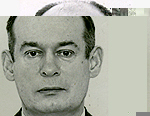Paul Steinhardt

Quasicrystal - Greetings from Outerspace
February 21, 2012 | 20:00
Dr. Paul Steinhardt, a professor of theoretical physics at Princeton University, discussed quasicrystals, an organizational form of matter that has changed the traditional understanding of crystals.
At the Digital October center, as part of the Knowledge Stream project and with support of Scientific American magazine, an extremely interesting lecture by Paul Steinhardt took place. Paul Steinhardht is a Princeton professor of Theoretical Physics who coined the term "quasicrystal" and discovered the structure's extraterrestrial origin.
Professor Steinhardt told the audience about quasicrystals, an organizational form of matter, which had changed the traditional understanding about crystals. Real models of quasicrystals are already flew to us: you could see them and even touch them! For the more daring attendees, Professor Steinhardt prepared a couple of tasks. So you could try to create a quasicrystal model with your own two hands.
Paul Steinhardt is a professor of Theoretical Physics at Princeton University, he is a Fellow in the American Physical Society and a member of the National Academy of Sciences as well as the recipient of the P.A.M. Dirac Medal and the Oliver Buckley Prize. Professor Steinhardt is best known for his work in theoretical cosmology and helped develop the theory of cosmic inflation, which explains the homogeneity and symmetry of the universe and the origin of the fluctuations that triggered the emergence of galaxies and the large-scale structure. Professor Steinhardt also works with condensed matter physics; recently he helped to develop a photonic quasicrystal for efficiently trapping and manipulating light in selected wavebands. A full biography of Professor Steinhardt in English can be read at Princeton website.
POST-LECTURE DISCUSSION PARTICIPANTS
-

Dmitry Strebkov
academician at the Russian Academy of Agricultural Sciences and at the Russian Academy of Natural Sciences, professor, PhD in Technology Sciences
-

Valery Kryachko
geologist, who accompanied Paul Steinhardt on his expedition to Chukotka
-

Yuri Vekilov
professor, Head of Department of Theoretical Physics at Moscow State Institute of Steel and Alloys
-

Vadim Urusov
PhD in Chemical Sciences, academician at the Russian Academy of Sciences, Head of the Department of Crystallography and Crystal Chemistry of the Geological Faculty at Moscow State University
-

Sergei Petukhov
PhD in Physics and Mathematical Sciences, PhD in Biology, Director of the Laboratory of Biomechanical Systems at the Institute of Mechanical Engineering at the Russian Academy of Sciences
-

Vladimir Reshetov
scientific observer of Scientific American magazine





































